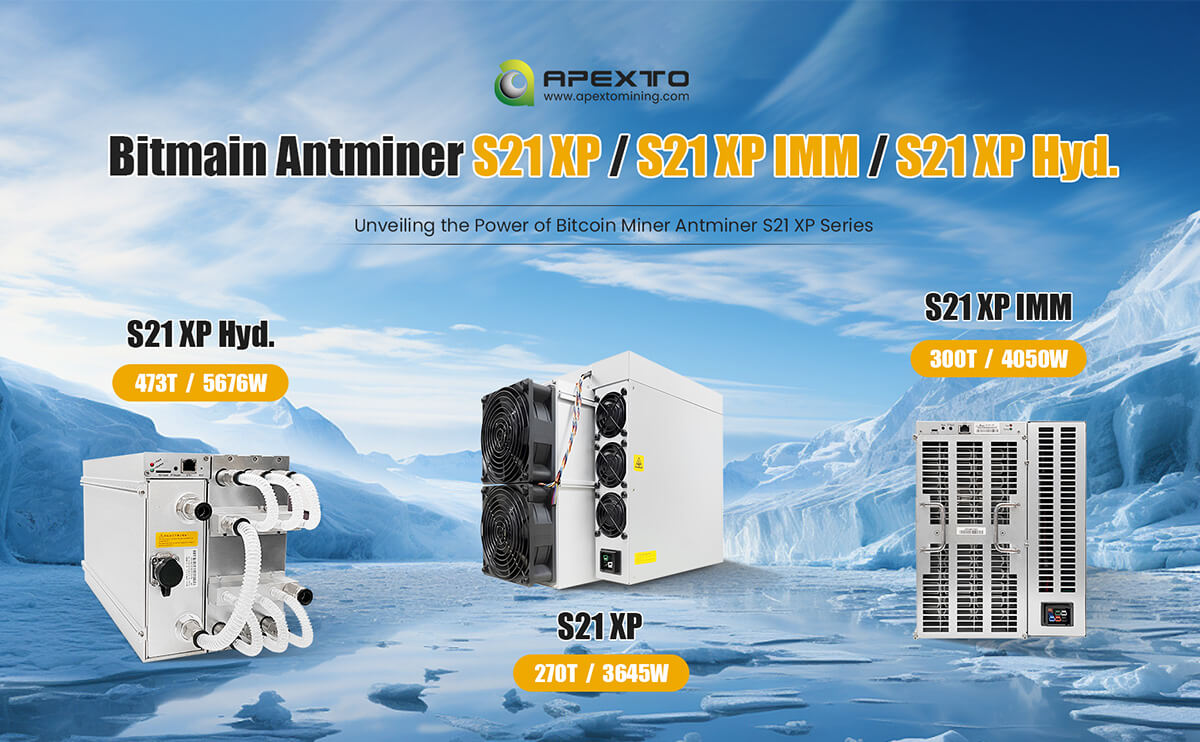Antminer S21 XP Series: Bitmain Unleashes Three Powerhouses – Antminer S21 XP, Hydro, IMM

Introduction
Bitmain has unveiled its latest Antminer S21 XP series, featuring three innovative ASIC mining models designed to meet diverse Bitcoin mining needs. The series includes the Antminer S21 XP, Antminer S21 XP Hydro, and Antminer S21 XP IMM, showcasing Bitmain’s continuous leadership in Blockchain ASIC miner technology. These new Bitcoin miners utilize advanced hydro cooling and immersion cooling solutions, optimizing performance and energy efficiency. With the SHA-256 algorithm, these ASIC miners deliver exceptional computing power, making them ideal for both professional and hobbyist miners looking to enhance their crypto mining operations. Cooling methods significantly impact Bitcoin miner performance, and this article will analyze the cooling types and functional characteristics of these models.
Antminer S21 XP Series: Performance and Profitability Analysis
The Antminer S21 XP series introduces three powerful Bitcoin mining models, each with unique cooling methods impacting their efficiency and profitability. Here’s a detailed breakdown of their performance and daily revenue potential:
| Model | Hash Rate (T) | Energy Efficiency (J/T) | Power Consumption (W) | Daily Revenue ($) | Electricity Cost ($) | Net Daily Profit ($) |
|---|---|---|---|---|---|---|
| Antminer S21 XP | 270 | 13.5 | 3645 | 12.366 | 5.2488 | 7.1172 |
| Antminer S21 XP Hydro | 473 | 12 | 5676 | 21.6634 | 8.17344 | 13.48996 |
| Antminer S21 XP IMM NEM | 300 | 13.5 | 4050 | 13.74 | 5.832 | 7.908 |
| Antminer S21 XP IMM HEM | 380 | 15 | 5700 | 17.404 | 8.208 | 9.196 |
The Antminer S21 XP delivers a hash rate of 270 TH/s with an energy efficiency of 13.5 J/T, resulting in a power consumption of 3645 W. This model generates a daily revenue of $12.37, with an electricity cost of $5.25, leading to a net daily profit of $7.12.
The Antminer S21 XP Hydro, equipped with advanced hydro cooling, offers a superior hash rate of 473 TH/s and an impressive energy efficiency of 12 J/T. This efficiency translates to a power consumption of 5676 W, daily revenue of $21.66, and electricity cost of $8.17, resulting in a substantial net daily profit of $13.49.
The Antminer S21 XP IMM series, featuring immersion cooling solutions, includes two variants:
- The NEM version has a hash rate of 300 TH/s at 13.5 J/T, consuming 4050 W. It generates a daily revenue of $13.74 and has an electricity cost of $5.83, resulting in a net daily profit of $7.91.
- The HEM version offers a hash rate of 380 TH/s at 15 J/T, with a power consumption of 5700 W. This variant provides a daily revenue of $17.40, with an electricity cost of $8.21, leading to a net daily profit of $9.20.
Different cooling methods—air, hydro, and immersion—significantly impact energy efficiency and profitability in crypto mining. Hydro cooling circulates liquid coolant through a closed-loop system with customized mining software, effectively dissipating heat from ASIC miners, while immersion cooling submerges the entire mining rig in a dielectric coolant, providing direct contact cooling for maximum efficiency. Both hydro cooling and immersion cooling solutions provide lower energy consumption and higher performance, making these ASIC miners ideal for various cryptocurrency mining operations. The Antminer S21 XP series exemplifies Bitmain’s continuous leadership in Bitcoin mining technology, offering tailored solutions to meet diverse mining needs and optimize returns. By incorporating advanced cooling methods, these miners enhance computing power and efficiency, crucial for maintaining a competitive edge in the blockchain ecosystem. Additionally, integrating efficient cooling techniques helps maximize the performance of mining software, ensuring miners can handle the demands of crypto mining more effectively. Bitmain’s innovative approach with the Antminer S21 XP series showcases its commitment to advancing cryptocurrency mining technology and supporting the growing needs of the crypto mining community.
Why Cooling Methods Affect Energy Efficiency in Bitcoin Mining
Cooling methods significantly impact the energy efficiency (measured in J/T) of Bitcoin mining hardware due to their effectiveness in heat dissipation, which in turn affects chip density and overall performance.
Hydro cooling, also known as liquid cooling, is a technique used in Bitcoin mining that utilizes cold plate water cooling technology. This method uses deionized water as the heat transfer medium in a closed-loop system, circulating water through heat exchangers without direct contact with electrical components. Hydro cooling offers improved cooling efficiency, scalability, flexibility, and lower operating costs compared to traditional air cooling solutions, making it ideal for cryptocurrency mining operations.
On the other hand, immersion cooling involves submerging Bitcoin mining equipment, such as ASICs (Application-Specific Integrated Circuits), in a non-conductive liquid coolant. This method provides direct contact cooling, allowing for superior heat dissipation and improved performance. Immersion cooling enhances energy efficiency, reduces thermal stress, increases equipment lifespan, and supports higher-density deployments. By eliminating the need for air cooling, immersion cooling minimizes noise pollution and optimizes the computing power of mining hardware, making it a highly effective solution for crypto mining and blockchain applications.
Here’s an explanation of how different cooling methods lead to differences in power consumption ratios in Bitcoin mining:
| Cooling Method | Advantage | Disadvantage |
| Air Cooling | – Cost-effective – Easy to install – Widely available – Versatile for different components |
– Limited cooling capacity – Noisy and accumulates dust – Potential for overheating – Higher energy consumption |
| Hydro Cooling | – Improved cooling performance – Quieter operation – Supports higher overclocking |
– Higher cost – More complex installation |
| Immersion Cooling | – Excellent cooling performance – Significant noise reduction – Minimal maintenance |
– Higher initial cost – Limited availability – Complex installation |
- Air CoolingMechanism: Air cooling uses fans and heatsinks to remove heat from Bitcoin miners, including ASIC miners. The fans blow air over heatsinks attached to the ASICs, dissipating heat into the surrounding environment.Impact on Energy Efficiency:
- Limited Cooling Capacity: Air has a lower heat capacity compared to liquids, limiting its ability to efficiently remove heat from mining hardware. This often leads to higher operating temperatures.
- Lower Chip Density: Due to less effective cooling, the chips need to be spaced further apart to avoid overheating. This lower chip density can limit the overall hash rate and increase the power consumption per unit of hashing power, affecting the energy efficiency of Bitcoin mining operations.
- Hydro CoolingMechanism: Hydro cooling, or liquid cooling, circulates liquid coolant through a closed-loop system to absorb and dissipate heat from ASIC miners more effectively than air.Impact on Energy Efficiency:
- Higher Cooling Efficiency: Liquids have a higher heat capacity than air, allowing them to absorb and dissipate more heat efficiently. This results in lower operating temperatures for Bitcoin miners.
- Higher Chip Density: Improved cooling allows for a denser arrangement of chips on the mining hardware. This enhanced chip density boosts the overall hash rate while maintaining or reducing power consumption, leading to better energy efficiency for crypto mining.
- Immersion CoolingMechanism: Immersion cooling solutions involve submerging the entire Bitcoin mining rig, including all ASICs, in a dielectric coolant or oil. The coolant directly absorbs heat from the ASIC chips and is then cooled externally.Impact on Energy Efficiency:
- Superior Heat Removal: Immersion cooling provides the most efficient heat dissipation, as the coolant makes direct contact with all components, removing heat more effectively than air or hydro cooling.
- Maximum Chip Density: The superior cooling efficiency supports the highest chip density, optimizing space and improving the overall hash rate. This leads to lower energy consumption per unit of hashing power, significantly enhancing energy efficiency for Bitcoin mining.
The cooling method impacts the energy efficiency of Bitcoin miners by influencing chip arrangement and operating temperatures. Air cooling, with its lower cooling efficiency, requires chips to be spaced out more, resulting in lower hash rates and higher power consumption. Hydro cooling improves efficiency by allowing denser chip arrangements, thus enhancing energy efficiency. Immersion cooling provides the best efficiency, supporting the highest chip densities and leading to the most optimized performance and energy consumption ratios. Effective cooling methods are crucial for maximizing the computing power and profitability of Bitcoin mining hardware.
Mining Containers
To meet miners’ needs for rapid deployment and to save time and costs in building mining farms, mining containers are becoming increasingly popular. They offer scalable and flexible crypto mining operations, providing enterprises with a cost-effective and efficient solution.
Mining containers are innovative, transportable solutions designed to house and operate cryptocurrency mining equipment, such as ASIC miners and GPUs, in optimal conditions. These containers, typically based on 10ft, 20ft, or 40ft standard shipping containers, are engineered for easy relocation and quick setup, offering plug-and-play capabilities. They come in two main cooling configurations: air-cooled hydro0cooled and immersion-cooled.
Air-cooled mining containers are designed for efficient air performance, using high industrial-grade components to ensure reliable operation in various environments. Immersion-cooled containers, like the Antminer AntSpace, submerge mining equipment in non-conductive liquid coolants, providing superior heat dissipation and energy efficiency. These containers can support a high density of miners, with a 20ft container hosting up to 256 Antminers or 320 Whatsminers, and a 40ft container accommodating up to 576 Antminers or 720 Whatsminers.
CONCLUSION
Mining containers are transforming the cryptocurrency mining industry by offering scalable, flexible, and cost-effective solutions. The Antminer S21 XP series, featuring the Antminer S21 XP, Antminer S21 XP Hydro, and Antminer S21 XP IMM, showcases the benefits of advanced cooling methods—air, hydro, and immersion—in enhancing energy efficiency and profitability. With superior heat dissipation and support for high-density deployments, these solutions maximize performance and reduce operational costs. As a result, mining containers like the Antminer AntSpace are essential for efficient and rapid deployment of mining farms, solidifying Bitmain's leadership in blockchain ASIC miner technology.








